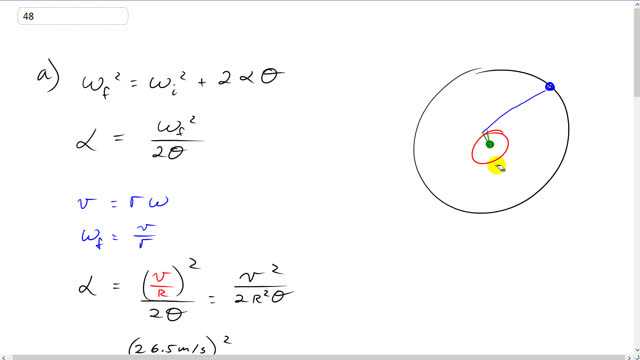
A hammer thrower accelerates the hammer (mass = 7.30 kg) from rest within four full turns (revolutions) and releases it at a speed of 26.5 m/s. Assuming a uniform rate of increase in angular velocity and a horizontal circular path of radius 1.20 m, calculate
- the angular acceleration,
- the (linear) tangential acceleration,
- the centripetal acceleration just before release,
- the net force being exerted on the hammer by the athlete just before release, and
- the angle of this force with respect to the radius of the circular motion. Ignore gravity.

In order to watch this solution you need to have a subscription.
This is Giancoli Answers with Mr. Dychko. Here is our top-down view of this hammer throw; here's the hammer going in its circle here and this is the person in the middle and this rope connecting the person's hands to the hammer... well, I assume it's a rope or else, it's some rod? I'm not even sure what a hammer throw is but anyway, it's a thing that goes around in a circle and it shows up in the Olympics. Anyway so this force is gonna be directed not towards the center because there's a tangental acceleration and there's a centripetal acceleration as well— oops, I didn't draw that right there— that centripetal acceleration goes directly towards the center and the force is gonna be directed along the line of the net acceleration the resultant acceleration right there. Okay! Now first question, what is the angular acceleration of this thing? So we know that the final angular velocity squared equals initial angular velocity squared which is zero plus 2 times angular acceleration times the angular displacement. So we can divide both sides by 2Θ to get α and then we know that the linear speed which we are told in this question equals the radius of its path times its angular velocity and we can rearrange this for ω by dividing both sides by r. So ωf equals V over R and so we'll replace that there with V over R and then that becomes v squared over 2R squared Θ. And so we are told that the final speed of this hammer throw is 26.5 meters per second squared and divide that by 2 times 1.20 meters— radius—squared times 4 revolutions which we have to convert into radians by multiplying by 2π radians per revolution and that gives 9.70 radians per second squared. The tangental acceleration... normally I advocate using original data from the question in answering questions and not using calculated results in subsequent calculations although in this case, it's so much easier to use this 9.70 that we're gonna do it anyway so we are taking a risk there. So its tangental acceleration is their radius times angular acceleration so that's 1.2 times 9.70196 radians per second squared which gives 11.6 meters per second squared. Centripetal acceleration at the very end when the hammer is just about to be thrown is the linear speed squared divided by the radius so that's 26.5 meters per second squared divided by 1.20 meters which is 585 meters per second squared. The resultant acceleration will have magnitude equal to the square root of the sum of the squares of the components of the acceleration— that's a mouthful— but anyway that's Pythagoras and the net force is gonna be mass times that acceleration. So we have m times square root of a T squared plus a C squared and that's 7.30 kilograms times the square root of 11.6423 meters per second squared squared plus 585.2083 meters per second squared squared which gives 4270 newtons. The angle which is this angle here with respect to the radius right in there that's Θ and you know the force is directed along this resultant acceleration as well and so Θ is, well, given by tan Θ is the tangental component divided by the centripetal component. If we were to zoom in on this triangle here if you like, we have we have the resultant a going this way and we have a C going this way and we have a T going this way and Θ's in there and so tan Θ is a T over a C and so that's what we have written here. And so Θ is inverse tangent of a T over a C that's inverse tangent of 11.6423 meters per second squared divided by 585.2083 meters per second squared which is about 1.14 degrees.